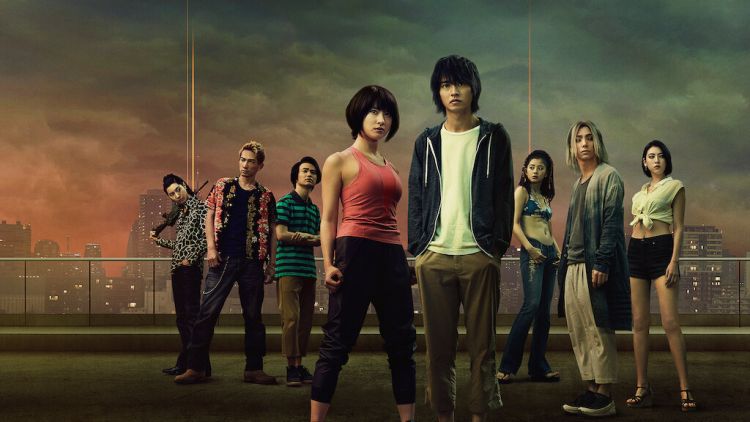Down the Deadly Rabbit Hole
Lately, it seems Netflix has taken an interest in live-action adaptations of anime and new anime adaptations of manga. The latest is the Japanese suspense show ‘Alice in Borderland.’ Despite the title, it’s not an adaptation of Lewis Carroll’s novel. Instead, the show is a live-action version of the Haro Aso manga series that admittedly does draw from Alice’s Adventures in Wonderland. The show focuses on people sucked into a world where they have to complete challenges to survive, similar to those of The Hunger Games (or, if you prefer, Battle Royale), but with a bit more intricacy.
First, I think it’s worth mentioning that your enjoyment of this show may depend on what kind of content you want to view during the COVID-19 quarantine. Generally, I feel there are two camps, that of “This is nice and uplifting and reminds me of pre-pandemic days,” and that of “At least I’m not those people.” Alice in Borderland falls aggressively into the latter category. It’s a grim show, boldly so, and it pulls no punches. But it can be surprisingly heartwarming from time to time.
At the onset, we’re introduced to a young man named Ryohei Arisu (Kento Yamazaki) who spends his time playing video games all day. Naturally, his father is disappointed in the slacker, forcing him to move out of the house. On his first day on his own, Arisu meets up with his friends Karube (Keita Machida) and Chota (Yuki Morinaga). Neither of them are exactly high achievers either, so the three friends goof off by Shibuya station and then hide in a bathroom cubicle when the police see them. Suddenly, the lights go out.
Up to this point, you’d be forgiven in thinking that this is a show about three best buds who goof off and have fun around Tokyo, causing all kinds of mischief. This is not that kind of program. That being said, this intro showcases the heart of Alice in Borderland, as we get to know various characters well and genuinely come to care about them over time. While the show focuses on the action and suspense of the challenges, it makes time for character development that typically pays off well. Initially, the show focuses on the trio, and for an excellent reason.
When the three friends go back into the plaza, they find it completely empty. No, they did not get transported into COVID-19 times; rather, they find themselves in an alternate version of Tokyo in which people are transported to play games to win cards, which in turn allow them to stay in the city and not get shot down with giant laser beams. The friends meet other people trapped in this world along the way, some who become allies, while others end up as enemies. Some of whom may stick around longer than others, and it’s not always who you expect. As such, you get the feeling that every single character in this world has a backstory, which serves to both sell the reality of the bizarre premise and add weight to the life-or-death games.
Aside from great character building, Alice in Borderland also benefits from clever writing implemented in the challenges our heroes have to complete. Each episode typically features one game, which paces the show well. The three kinds of games involve either puzzle-solving, physical skill, or manipulation. But for each one, there’s an interesting conceit or exploit that allows viewers to figure out the best solutions along with the characters.
This is thanks to deliberate camera work that doesn’t obscure any of the clues and provides enough angles for viewers to figure out the games themselves. That’s not to say they’re easy to guess. If you’ve ever thought hard about the trolley car dilemma, this is a show for you, especially if your solution to it is an unconventional one.
Shinsuke Sato, who’s no stranger to live-action adaptations of Manga or game theory, directs Alice in Borderland with precision and an eye for suspense. Despite the focus on outwitting the games, the show is remarkably fast-paced, with thrilling action scenes.
Our three friends all come off feeling like unique and believable characters, partly thanks to great acting. A couple of other examples of great performances come later when we meet mountain climber Usagi and martial artist Kuina, played by Tao Tsuchiya and Aya Asahin, respectively. They provide exciting fight scenes and have rousing backstories of how they overcame adversity before the games. This exemplifies the blend of visual flair and dramatic tension that allows the show to achieve victory, even when the scenarios look bleak.
Alice in Borderland Review
Summary
The violent and bleak setting of Alice in Borderland will not suit everyone’s tastes, but the episodic nature of exploring different games alongside the overarching mystery of why everyone disappeared make for an eight-episode Netflix offering that is bingeable and intriguing.
Pros
- Great acting and well-written characters across the board
- Clever puzzles with even more clever solutions
- Expertly directed action sequences
- Deliberate and meaningful cinematography
Cons
- A grim show during a grim time
- The knowledge that none of your favorite characters are safe
-
Alice in Borderland Review





